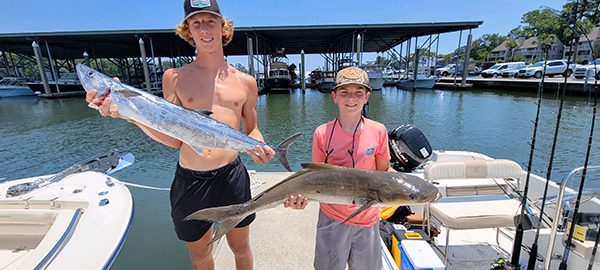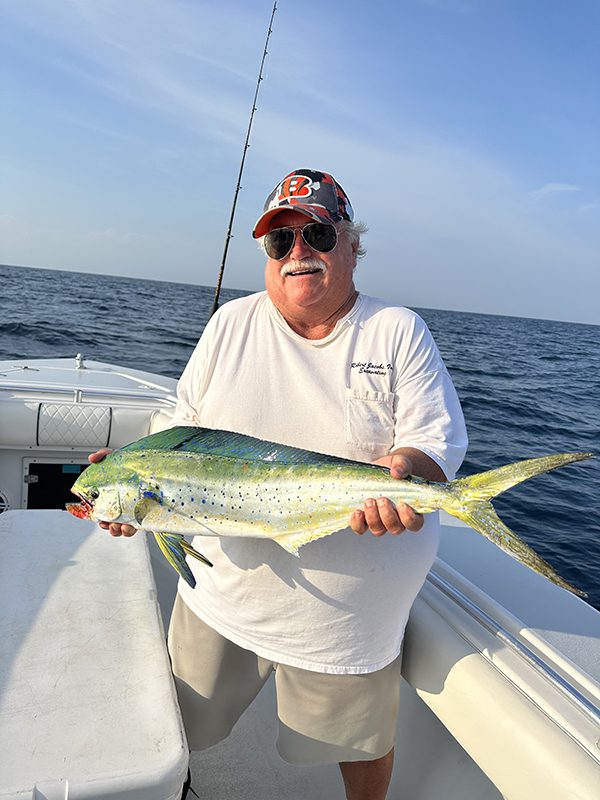Topsail/Sneads Ferry – September 2023
Jerry, of East Coast Sports, reports that red drum are scattered throughout the backwaters. Anglers are having the most success with topwater plugs early, and then using cut or live bait at other times of the day.
Sheepshead and black drum are being caught with crabs around the area’s bridges and some deeper docks.
Nearshore anglers are still finding Spanish mackerel, though most of these are smaller, summertime fish. Fishing live bait will provide the best chance to hook into a bigger Spanish or one of the scattered king mackerel that are along the beach.
Offshore runs are producing wahoo and sailfish.
Bottom fishing remains strong, though most are finding the deeper areas (120’+) holding better numbers.
Mike, of Native Son Guide Service, reports that the area is just starting to see the push of finger mullet. These mullet add to the good amounts of shrimp and menhaden that have already moved in.
Red drum action has been good. Getting out early is key, with topwater plugs seeing some success. As the day moves on, the fish quickly get sluggish and Carolina-rigged natural cut baits provide the best chances of success. A rising tide also gives the fish a little relief from hot water temperatures and can help get them feeding.
Speckled trout are sprinkled around, though they are mostly a late night or early morning bite.
Flounder are mixed in just about everywhere.
Nearshore anglers have been finding the Spanish mackerel action to be a bit slow, but the good news is that occasional schools of false albacore are starting to show.
The nearshore reefs are holding black sea bass, grunts, and porgies.

Ty Williams (left) and Joe Potanovic (right), both of Wilmington, with a 39″ king and a 38″ cobia. The king was caught on a frozen cigar minnow, and the cobia fell for on a Roscoe jig. They were fishing five miles offshore of Figure 8 Island.
Ray, of Spring Tide Guide Service, reports that anglers have been seeing a good amount of over-slot red drum. The finger mullet have just started to show up in the area, and as the mullet move in even more, the red drum bite should get even better.
With water temperatures touching 90, some mixed black drum are the only other species being active.
Nearshore anglers are seeing waves of Spanish mackerel, but overall the bite is spotty.
Bottom structure off the beach is producing grunts, black sea bass, and small grouper. Flounder are also mixed in around these same nearshore areas.
Chadwick, of South End Anglers, reports that flounder fishing has been good both inshore and out on nearshore structure. Inside, anglers should target areas such as creek mouths, grass points, cuts through oyster bars, and docks. Carolina-rigged live finger mullet will be best for enticing strikes, but soft plastics such as Z-Man, Salty Bay soft plastics, or bucktails rigged with Gulp will also be effective.
Red drum action is pretty good inshore, with fish found around docks, near oyster beds, and in bays. Topwater plugs are having success early or on the cloudy days. Sub-surface hard lures are also working well when the topwater bite starts to slow. As the days moves on, it’s been best to switch over to Carolina-rigged mullet or menhaden.
Some speckled trout are being caught at night around dock lights in the ICW. You can also find some fish early around the inlets and larger creek mouths.
Nearshore runs are producing decent bottom fishing, with catches of black sea bass, grunts, ringtails, triggerfish, grouper, and short cobia.
Daniel, of Surf City Charters, reports that anglers on recent trips have been hammering the red drum. Live finger mullet has been the ticket, with target areas varying from shallow bays to creeks and grass beds.
A bunch of flounder are also striking these live baits dragged along the bottom. Most of the flatfish are being caught in bays or around docks.
Nearshore runs are starting to see a few Spanish showing back up, and king mackerel and mahi are being caught in the 15-20 mile range.
Gulf Stream action is centered around sailfish and wahoo.
Jim, of Plan 9 Charters, reports that Spanish mackerel fishing has remained steady, with the best action being early in the morning right outside the inlets. The fish are tuned in on some really small baits right now, so the smaller 00 sized Clarkspoons and smaller casting jigs are producing best. When breaching the inlet, start looking for birds to find these schools.
A few schools of false albacore have popped up and will respond to the same tactics.
The king mackerel bite has been best in the 20+ mile range.
Bottom fishing action is strong in the 80-100’ range. Cut baits are producing a variety of grouper, vermilion snapper, and black sea bass.
Nearshore reefs closer to the beach are seeing gray trout moving in.

Keith Wilcox, of Cincinnati, OH, caught this mahi on a Blue Water Candy wedgie with squid. He was fishing 15 miles offshore of Topsail Beach with Capt. Daniel Batts, of Surf City Charters.
Robin, of Jolly Roger Pier, reports that anglers fishing at night have seen some of the better bottom fishing action. These catches have included sea mullet, spots, and speckled trout.
Anglers looking for a sight-casting bite are having the most success both early in the morning and in the evening. Nice-sized Spanish mackerel (to 3.5 lbs.) and bluefish are being caught.
Anglers off the end have had a few king mackerel hookups, but it will likely be a few more weeks before temperatures cool and better numbers move onto the beach.
Vinita, of Surf City Pier, reports that anglers live baiting have landed some nice-sized king mackerel (to 23 lbs.).
Spanish mackerel and bluefish have been around in decent numbers, with the slightly cooler morning and late afternoon hours being best.
Bottom fishing efforts are producing sea mullet, pompano, and spadefish.
Speckled trout have continued to show up in the catches (mostly at night).
Sean, of Seaview Pier, reports that Spanish mackerel fishing has been reasonably good (especially when there’s clear water conditions).
Live bait fishing off the end hasn’t produced any king mackerel, but it’s only a matter of time before these fish start pushing in closer to the beaches.
Nighttime anglers have been catching some sea mullet.
Bottom fishing anglers are catching a bunch of flounder.
